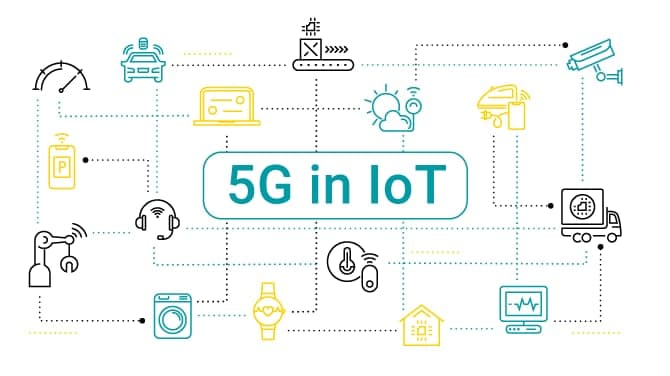How Does 5G Technology Enhance the Internet of Things?

The Internet of Things (IoT) has already transformed the way we live, work, and interact with technology. From smart home devices to industrial automation, IoT is everywhere. But the real game-changer in unlocking its full potential is 5G technology.
5G, the fifth generation of wireless technology, offers ultra-fast data speeds, extremely low latency, and massive network capacity. These advancements are redefining what’s possible in the IoT ecosystem.
Let’s explore how 5G technology enhances the Internet of Things, the key benefits it brings, and why it’s crucial for the future of smart connectivity.
The Role of 5G in IoT: A Game-Changer in Connectivity
The current 4G networks are limited in handling the vast number of connected devices in today's IoT environment. Here’s where 5G in IoT becomes vital:
- Increased bandwidth allows more devices to connect simultaneously without interference.
- Ultra-low latency ensures real-time communication between devices, essential for applications like autonomous driving or remote surgery.
- Greater reliability ensures that even mission-critical IoT operations can function seamlessly.
With these capabilities, 5G isn't just an upgrade—it's the backbone of the future IoT infrastructure.
Key Benefits of 5G for IoT
1. Faster Data Transmission
Speed is one of the most touted advantages of 5G. Compared to 4G, 5G can deliver speeds up to 100 times faster. This speed enables IoT devices to transmit and receive data almost instantly.
Example:
A smart surveillance camera powered by 5G can stream 4K video in real-time with minimal lag—critical for public safety or security applications.
2. Massive Device Connectivity
5G networks can support up to 1 million devices per square kilometer, making it ideal for environments like smart cities or industrial IoT.
How it helps:
- Enables cities to deploy thousands of IoT sensors for traffic management, pollution monitoring, and public utilities.
- Facilitates smart manufacturing with seamless communication between machines, sensors, and robots.
3. Ultra-Low Latency for Real-Time Applications
Latency refers to the delay before data transfer begins. With 5G, latency can be reduced to just 1 millisecond, allowing devices to interact in real-time.
Real-world impact:
- In autonomous vehicles, 5G allows cars to make split-second decisions by instantly processing data from nearby sensors and vehicles.
- In healthcare, surgeons can perform robotic surgeries remotely with precise, real-time control.
4. Improved Energy Efficiency
5G is designed with energy-saving capabilities. IoT devices, especially those running on batteries, benefit from longer operational lifespans.
Why it matters:
Smart sensors in agriculture or logistics can remain functional for years without maintenance, increasing efficiency and lowering costs. Also Read About
5. Enhanced Network Slicing for IoT Customization
5G introduces a powerful feature called network slicing, which allows operators to create virtual networks customized for specific applications.
Application:
- A smart factory may need ultra-reliable and low-latency communication, while a smart meter may only require occasional data transmission. With 5G, each use case gets a tailored slice of the network.
Real-World Applications of 5G and IoT
Smart Cities
5G enables smarter, more connected urban environments:
- Real-time traffic data collection
- Intelligent lighting systems
- Waste management optimization
- Emergency response enhancements
Healthcare
The healthcare industry is embracing 5G-powered IoT to:
- Monitor patients remotely using wearables
- Enable faster transmission of large medical files
- Conduct real-time telemedicine consultations
Manufacturing & Industry 4.0
Industrial IoT (IIoT) powered by 5G allows:
- Predictive maintenance using connected sensors
- Automation of manufacturing lines
- Real-time analytics and quality control
Agriculture
Smart farming solutions use 5G to:
- Monitor soil moisture and crop health
- Automate irrigation systems
- Track livestock in real time
Challenges to Consider
While 5G is poised to transform the IoT landscape, a few challenges need addressing:
- Infrastructure costs: Deploying 5G requires extensive investment in small cell towers and fiber backhaul.
- Device compatibility: Many existing IoT devices aren’t built for 5G and may need upgrades.
- Security concerns: A more connected world introduces more vulnerabilities, making cybersecurity crucial.
The Future of 5G and IoT: What Lies Ahead?
The convergence of 5G and IoT marks the beginning of a new technological era. According to industry experts, the number of IoT devices will exceed 30 billion by 2030, and 5G will be instrumental in managing and connecting this digital ecosystem.
Future possibilities include:
- Fully autonomous public transportation
- Smart energy grids with real-time optimization
- Hyper-personalized retail experiences
- AI-driven supply chains
As 5G continues to evolve, we can expect even more innovative applications that reshape industries and improve everyday life.
Conclusion:
So, how does 5G technology enhance the Internet of Things? By supercharging speed, reducing latency, increasing capacity, and enabling massive-scale connections, 5G unlocks the full promise of IoT.
Whether it’s smart homes, cities, industries, or healthcare, the synergy between 5G and IoT is driving a smarter, more connected world.
Businesses and developers who invest in this technology today will be at the forefront of tomorrow’s innovations.
FAQs:
Q1: What makes 5G better than 4G for IoT?
A: 5G offers faster speeds, lower latency, and supports many more connected devices than 4G.
Q2: Will all IoT devices need to upgrade to 5G?
A: Not all, but devices requiring real-time response or higher bandwidth will benefit greatly from 5G.
Q3: Is 5G secure for IoT applications?
A: Yes, 5G includes enhanced encryption and network security protocols, but device-level security is still essential.
